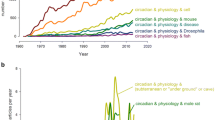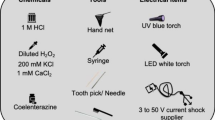Summary
A new, fully computerized method for the measurement and analysis of dinoflagellate bioluminescence has been developed and applied to the spontaneous light emission ofGonyaulax polyedra. This light emission consists of a low-level steady glow, and occasional superimposed flashes. The instrumentation distinguishes the two components and records them separately; both exhibit circadian rhythmicity. In this paper we describe the method in detail, and show results for flashing and glow measured under light: dark cycles and under constant light of different intensities. Under constant dim light at 19°C, both rhythms exhibit two peaks during a circadian cycle; the minor ones occur approximately nine hours before the major ones. Under these conditions the major flashing peak occurs early during the subjective night, and the major glow peak at the end, about nine hours later. However, the relative phase angle between glow and flashing peaks varies with light intensity, being as little as 220 min (3.7 h) in the dark under light-dark entrained conditions, to as much as 700 min (11.7 h) in dim light under free-running conditions. The ambient light intensity also affects differentially the amount of light emitted in the two modes of spontaneous luminescence. These results suggest that the controls for the two processes must at some point diverge.
Similar content being viewed by others
References
Biggley, W.H., Swift, E., Buchanan, R.J., Seliger, H.H.: Stimulable and spontaneous bioluminescence in the marine dinoflagellatesPyrocystis bahamensis, Gonyaulax polyedra, andPyrocystis lunula. J. Gen. Physiol.54, 96–122 (1969)
Bode, V.C., DeSa, R.J., Hastings, J.W.: Daily rhythm in luciferin activity inGonyaulax polyedra. Science141, 913–915 (1963)
Dunlap, J.C., Taylor, W., Hastings, J.W.: The effects of protein synthesis inhibitors on theGonyaulax clock: I. Phase-shifting effects of cycloheximide. J. Comp. Physiol.138, 1–8 (1980)
Guillard, R.R.L., Ryther, J.H.: Studies of marine planktonic diatomsI. Cyclotella nana Hustedt, andDetonula confervacea (Cleve) Gran. Can. J. Microbiol.8, 229–239 (1962)
Hastings, J.W.: Unicellular clocks. Ann. Rev. Microbiol.13, 297–312 (1959)
Hastings, J.W.: Biochemical aspects of rhythms: Phase shifting by chemicals. Cold Spring Harbor Symp. Quant. Biol.25, 131–143 (1960)
Hastings, J.W.: Bacterial and dinoflagellate luminescent systems. In: Bioluminescence in action. Herring, P. (ed.), pp. 129–170. London: Academic Press 1978
Hastings, J.W., Sweeney, B.M.: The luminescent reaction in extracts of the marine dinoflagellateGonyaulax polyedra. J. Cell. comp. Physiol.45, 209–225 (1957)
Hastings, J.W., Sweeney, B.M.: A persistent diurnal rhythm of luminescence inGonyaulax polyedra. Biol. Bull.115, 440–458 (1958)
Hastings, J.W., Sweeney, B.M.: The action spectrum for shifting the phase of the rhythm of luminescence inGonyaulax polyedra. J. Gen. Physiol.43, 697–906 (1960)
Hastings, J.W., Weber, G.: Total quantum flux of isotropic sources. J. Opt. Soc. Am.53, 1410–1415 (1963)
Hastings, J.W., Astrachan, L., Sweeney, B.M.: A persistent daily rhythm in photosynthesis. J. Gen. Physiol.45, 69–76 (1961)
Karakashian, M.W., Hastings, J.W.: The effects of inhibitors of macromolecular biosynthesis upon the persistent rhythm of luminescence inGonyaulax. J. Gen. Physiol.47, 1–12 (1963)
Krasnow, R., Dunlap, J.C., Taylor, W., Hastings, J.W., Vetterling, W., Haas, E.: Measurements ofGonyaulax bioluminescence, including that of single cells. In: Recent developments in marine bioluminescence. Nealson, K. (ed.). Minneapolis, Minn.: Burgess 1980
McDaniel, M., Sulzman, F.M., Hastings, J.W.: Heavy water slows theGonyaulax clock: a testing of the hypothesis that D2O affects circadian oscillations by diminishing the apparent temperature. Proc. Natl. Acad. Sci.71, 4389–4391 (1974)
Mitchell, G., Hastings, J.W.: A stable inexpensive solid state photomultiplier photometer. Anal. Biochem.39, 243–250 (1971).
Njus, D., McMurry, L., Hastings, J.W.: Conditionality of circadian rhythmicity: Synergistic effect of light and temperature. J. Comp. Physiol.117, 335–344 (1977)
Sweeney, B.M.: Biological Clocks in Plants. Ann. Rev. Plant Physiol.14, 411–440 (1963)
Sweeney, B.M.: Rhythmic phenomena in plants. Vol. 3 of Exp. Bot. Monog. London: Academic Press 1969
Sweeney, B.M., Hastings, J.W.: Characteristics of the diurnal rhythm of luminescence inGonyaulax polyedra. J. Cell. Comp. Physiol.49, 115–128 (1957)
Sweeney, B.M., Hastings, J.W.: Rhythmic cell division in populations ofGonyaulax polyedra. J. Protozool.5, 217–224 (1958)
Sweeney, B.M., Haxo, F.T., Hastings, J.W.: Action spectra for two effects of light on luminescence inGonyaulax polyedra. J. Gen. Physiol.43, 285–299 (1959)
Taylor, W., Gooch, Van D., Hastings, J.W.: Period shortening and phase shifting effects of ethanol on theGonyaulax glow rhythm. J. Comp. Physiol.130, 355–358 (1979)
Author information
Authors and Affiliations
Rights and permissions
About this article
Cite this article
Krasnow, R., Dunlap, J.C., Taylor, W. et al. Circadian spontaneous bioluminescent glow and flashing ofGonyaulax polyedra . J Comp Physiol B 138, 19–26 (1980). https://doi.org/10.1007/BF00688730
Accepted:
Issue Date:
DOI: https://doi.org/10.1007/BF00688730




